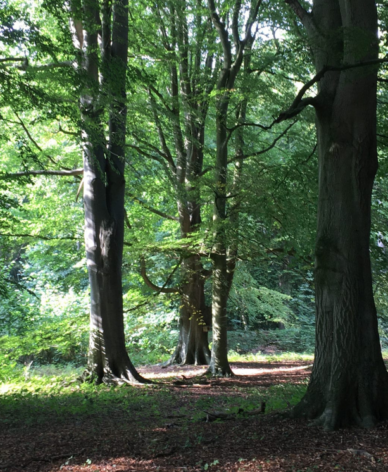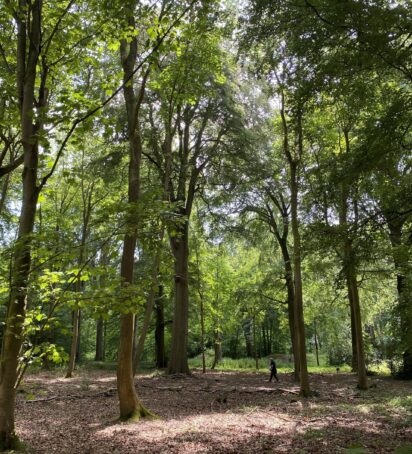The Estate covers an area of over 3,000 acres. We are very lucky that we start from an excellent base with woodland covering 20% of the whole, amounting to some 655 acres, or twice the national average.
We have many miles of traditional hedgerows, and Rougham is famous for its wonderful oak trees which are a hallmark of the Estate. They line the roads, and footpaths, they march along the field edges and fill the woods. This native oak tree, Quercus robur, is probably the most important landscape tree in the country.
It is also the tree that hosts the most wildlife and is one the longest lived, and so one of the most important trees nationally. We have many ancient examples, known as veteran trees. Some of the most important are located in one of the rarest of habitat types, an ancient wood pasture. Other important tree types on the Estate are Hornbeam pollards, Elm pollards and towering Beech trees.

The Woodlands
Over 110 acres of our woodlands are ancient semi-natural woodland, which dates back to the great forests of the Middle Ages and before. This woodland is included within two Higher-tier Countryside Stewardship Schemes (a government environmental scheme). As part of these schemes we are regenerating the ancient hazel coppice of these woods which provide an important habitat for dormouse and encourage native flora such as early purple orchids, oxslips, native English bluebells, dog violets and wild garlic.
The Estate woodlands are managed by the Rougham Estate Trust, whose objects include wildlife conservation. The Rougham Estate Trust is advised particularly by the Suffolk Wildlife Trust who conduct many wildlife surveys across the Estate each year. These help us to not just know what is living here but also help us monitor the effectiveness of the conservation work being undertaken. Rare bats and butterflies are some of many highlights identified during these surveys.

Water Sources
Suffolk is one of the driest parts of the country, famously drier than Jerusalem. In such an area, ponds and other water sources are very important. The estate has many field ponds, hedgerow ponds and woodland ponds. Many of these have become silted up over the years and there is an active programme of pond restoration on the Estate. During the 1960s many hybrid poplar trees were planted around ponds. They were intended as a commercial crop to be sold to Bryant and May, to make matches. With the fall of the Iron Curtain and the fresh availability of cheap timber from the Baltic States the poplars were no longer required and so grew on, sucking all the water out of the ponds in the process. Part of the restoration process is to remove the offending poplar trees.
Over the last 40 years the Estate has planted many miles of native mixed field hedges and hundreds of road- and field-side oak trees. These hedgerows contribute to the landscape here with its pre-existing ancient hedgerows written about the great Oliver Rackham in his book ‘The History of the English Landscape’.
The Rougham Estate also has the upper reaches, if not the source, of the Black Bourne river. With us it is little more than a stream which is currently running through a ditch. It is hoped to be more imaginative with this wonderful asset in the future, and perhaps creating a wetland area, involving the removal of yet more of the hybrid poplars, referred to above.
Mid-tier Countryside Stewardship Scheme
The Rougham Estate, as part of its commitment to conservation, is part of an additional Mid-tier Countryside Stewardship Scheme across the arable land and permanent pasture.
As part of this scheme, we have a wide range of environmental features such as Skylark plots within arable fields, grass and flower enriched margins protecting hedgerows and water courses as well as providing a habitat for nesting birds.
We have over 110 acres of pollen and nectar strips and wild bird seed plots for pollinators and to bridge the hunger gap for farmland birds during the winter months. Our permanent pasture is all managed as a low input system to encourage biodiversity of insects and all of the hedgerows across the Estate are cut in rotation, meaning that they are not cut every year, to create a diversity of hedgerows for nesting birds.







